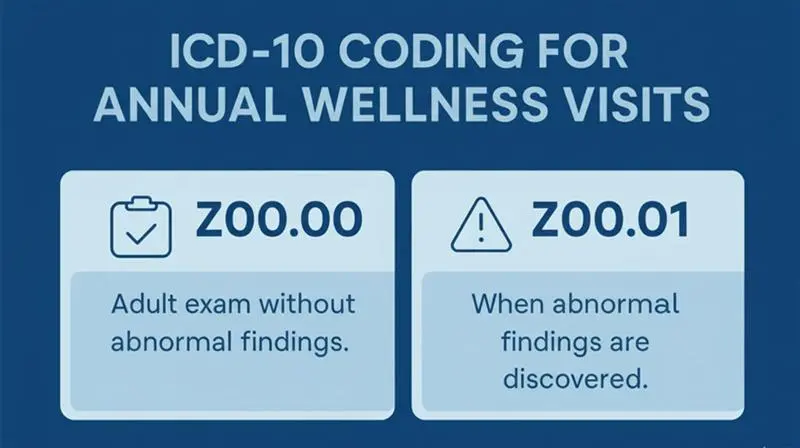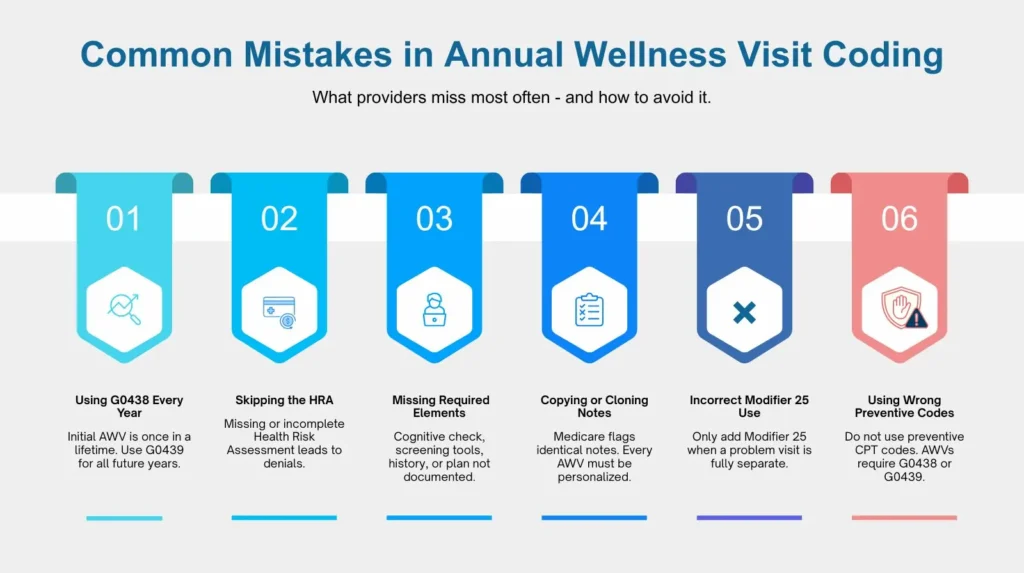Annual Wellness Visit Coding begins with a single question. How do you guide a visit that appears simple on the surface yet carries so much weight beneath it? You sit with the patient. You ask about their health. You sense the story, which they bring with them. And you know, even before the note begins, that this visit shapes their future path.
So what choices will you make? What details will protect the claim? What steps will strengthen the plan? These questions give direction. Because Annual Wellness Visit Coding is not just billing. It is strategy - It is structure - It is the quiet framework behind prevention. Let us walk through this process the same way professionals study a trail. Calm, purposeful, and alert.
What is Annual Wellness Visit Coding and Why Does it Matter in 2025?
What makes an Annual Wellness Visit different? Why does Medicare treat it with such precision? According to CMS, the AWV exists to build a personalized prevention plan. It reviews risks. It identifies gaps, and it informs long-term health. And where does Annual Wellness Visit Coding fit within that purpose? At each step because accurate coding protects reimbursement and supports compliance. It makes sure the visit’s intent is understood and correctly recorded.
If the HRA is missing, the claim fails. If the plan is generic, Medicare questions it. If the documentation is incomplete, auditors notice. This is why Annual Wellness Visit Coding matters so much in 2025. It stands at the crossroads of patient care and operational survival.
How Do G0438 and G0439 Differ in Medicare Wellness Visits?
Two codes define the AWV landscape. Both simple, both powerful, and both requiring absolute clarity. G0438 is the Initial AWV. The first chapter. A one-time event that never repeats. G0439 is the Subsequent AWV. The annual follow-up. A chance to update the plan and address new risks.
So what controls the choice between these codes? Timing, history, and eligibility. Medicare allows G0439 only once every 12 months plus one day. That extra day matters. Without it, the claim breaks.
Code G0438 vs G0439
| Code | Visit Type | Core Requirements | Frequency | Notes |
|---|---|---|---|---|
| G0438 | Initial AWV | First time risk and history review | Once per lifetime | Establishes baseline plan |
| G0439 | Subsequent AWV | Updated assessment and prevention plan | Every 12 months plus 1 day | Cannot precede initial AWV |
What Documentation Is Required for G0438 and G0439 in 2025?
Why does Medicare focus so heavily on documentation? Why does each required element matter? Because each part shapes the prevention plan. Each one adds to the risk picture. Each contributes to long term care decisions. According to CMS, every AWV must include: The Health Risk Assessment. Medical and family history. Medication review. Provider and supplier list.
Routine measurements such as height, weight, BMI, and blood pressure. Cognitive assessment. Depression screening, fall risk assessment, functional ability review, and home safety review. A personalized prevention plan. If you miss any part, the AWV becomes incomplete. And incomplete visits do not survive the demands of Annual Wellness Visit Coding.
Which AWV Elements Must Be Documented to Avoid Coding Denials?
Now let us explore each required element with rhythm and clarity. Because each one affects the visit’s fate.
Health Risk Assessment Structure
Why does the HRA matter so much? Because it reflects the patient’s experience. Their habits. Their struggles. Their risks. The patient completes it. You review it. You build the plan from it. CMS expects a clear link between the HRA and the prevention plan.
List of Risk Factors
What risks shape a patient’s future? Activity levels, diet patterns, chronic conditions, family history, vision changes, and balance issues. You list these openly and clearly. They give structure to your counseling and plan. They guide Annual Wellness Visit Coding toward accuracy.
Screening Schedule
What should the next 5 to 10 years look like for this patient? Screenings follow USPSTF and CMS coverage guidance. Diabetes checks. Colonoscopies. Vaccines. Mammograms. Bone density testing. This schedule must reflect the patient’s unique profile. Not a template. Not a copy. A genuine plan.
Advance Care Planning
Patient Counseling
Personalized Wellness Plan
Required AWV Documentation Elements
| Element | Description | Who Completes It |
|---|---|---|
| HRA | Lifestyle and risk review | Patient and provider |
| History | Past medical and family details | Provider |
| Medication review | Updated medication list | Provider |
| Cognitive check | Basic cognitive screen | Provider |
| Depression and fall risk | Standard tools used | Provider |
| Function and safety | ADLs and home safety | Provider |
| Prevention plan | Personalized plan | Provider |
ICD-10 Coding for Annual Wellness Visits
Does Medicare require a specific ICD-10 for AWVs? According to CMS, the answer is no. But two codes guide these visits:
- Z00.00 for general adult exam without abnormal findings.
- Z00.01 when abnormal findings are discovered.
The rule is simple. If you code it, you must show it. If the finding is not documented, do not use Z00.01. Clear ICD selection supports clean Annual Wellness Visit Coding.
What Add-On Services Can Be Billed with G0438 or G0439 AWVs?

What can you add to an AWV? Which services fit the visit without breaking its purpose? Medicare allows several add-ons, each with its own rules, each with its own weight.
- G0444 for depression screening: This code supports a structured, evidence-based tool that looks for early signs of depression. The screen must be documented with care and tied to the risks the patient carries.
- G0442 for alcohol misuse: This service uses a brief, validated assessment to uncover harmful drinking patterns. You must record the tool used, the findings, and the discussion that follows.
- G0446 for cardiovascular counseling: This code applies when you guide the patient through behavior changes linked to heart health. Diet. Activity. Daily habits. The advice must reflect the patient’s real risks.
- G0447 for obesity counseling: Use this when the patient’s BMI reaches 30 or higher. The conversation should stay focused on weight-related risks and small, realistic steps toward change.
- 99497 and 99498 for advance care planning: These codes belong to moments when patients choose to discuss future decisions. You document the time. You document the topics. Directives. Proxies. Wishes for the road ahead.
Each add-on stands on its own. Each demands its own note. Each must connect directly to the risks uncovered in the visit. Handled with care, these services strengthen your work and support clean Annual Wellness Visit Coding.
Add-On Services Allowed with AWVs
The fight inside Internal Medicine RCM Challenges is not won with paper or patience. It is won with precision. With tools that do not blink and do not tire. Each one built for purpose. Each one exact in its strike. They move together. Silent. Certain. One cleans. One tracks. One predicts. In their rhythm, billing changes. It becomes steady. Sharp. Alive.

| Code | Service | When It Applies | |||||||||||
|---|---|---|---|---|---|---|---|---|---|---|---|---|---|
| G0444 | Depression screening | Annual tool-based screen | |||||||||||
| G0442 | Alcohol misuse screening | Brief assessment and counseling | |||||||||||
| G0446 | Cardiovascular therapy | Behavioral counseling | |||||||||||
| G0447 | Obesity counseling | BMI 30 or higher | |||||||||||
| Audit Trigger | Why It Draws Attention |
|---|---|
| Missing elements | Medicare expects every AWV component to be present. Any gap stands out. |
| Generic prevention plans | Plans must reflect the patient. Templates reveal themselves instantly. |
| Cloned or copied notes | Repeated text signals inaccuracy. Auditors notice when stories do not change. |
| Weak counseling documentation | Counseling must connect to real risks, not vague advice. |
| Incorrect code timing | AWWs billed too early trigger automatic denials and deeper review. |
| Incomplete HRA handling | The HRA must be completed, reviewed, and reflected in the plan. Anything less is insufficient. |
How Does Pro-MBS Improve Annual Wellness Visit Coding Accuracy?
Every clinic feels the strain at some point. The missed elements. The denials that return without warning. The audits that arrive quiet and cold. The gaps in documentation that seem small but cut deep when Medicare reviews the claim. You try to keep the workflow steady, yet the AWV rules shift, tighten, and demand more detail each year. And with every added requirement, the pressure grows. One missing HRA. One weak prevention plan. One early timing error. That is all it takes to break the claim.
This is where Pro-MBS steps in with steady hands. We build AWV templates shaped around CMS expectations, not guesswork or shortcuts. We run eligibility checks before the visit begins, so timing never surprises you. We review each Health Risk Assessment to make sure it is complete, clear, and ready to guide the plan. We look for add-on opportunities that match the patient’s actual risks.
Our QA team studies every note with quiet focus. They look for missing elements. They look for gaps that auditors search for. They look for anything that could weaken the claim. Then we run clean claim validation to keep denials away and apply payer-specific rules so each submission moves through the system without resistance. The result is simple. Your workflow becomes smoother. Your documentation becomes stronger. Your revenue becomes safer. And your Annual Wellness Visit Coding rises to a level that stands firm under audit, review, and time.
Frequently Asked Questions
How do I know whether to use G0438 or G0439 for an AWV?
Choosing between G0438 and G0439 depends on the patient’s timing and history. G0438 is the first chapter, a once-per-lifetime Initial AWV that sets the foundation. G0439 follows annually and carries the updated plan forward. Using the wrong code weakens your Annual Wellness Visit Coding and risks denial. For clear and confident coding choices, Pro-MBS can guide each visit.
What happens if required AWV documentation is missing?
Missing AWV Documentation creates cracks in the visit. When elements like the HRA, vitals, or counseling fall out of place, Medicare sees the gaps instantly. The plan loses structure and denials follow quickly. Strong documentation strengthens your Annual Wellness Visit Coding and protects the claim. Pro-MBS can help secure every detail before submission.
Do I need specific ICD-10 codes for AWV billing?
No single code is required for AWVs, but two ICD-10 codes anchor most encounters. Use Z00.00 when the exam shows no abnormal findings and Z00.01 when risks or changes reveal themselves. The code must match the story in the chart. Clean coding protects the flow of Annual Wellness Visit Coding. For accuracy without doubt, rely on Pro-MBS.
Can I bill add-on services during an AWV?
Yes, but each add-on must fit the patient’s needs with precision. Codes like G0444, G0442, G0446, G0447, and 99497/99498 add value only when documentation supports them. Each one requires its own note, its own purpose, and its own connection to risk. Used well, they expand your Annual Wellness Visit Coding. Pro-MBS can help you identify the right add-ons every time.
When should Modifier 25 be used with an AWV?
Modifier 25 applies only when a separate problem visit rises clearly apart from the AWV. The issue must be significant, identifiable, and documented on its own. Weak separation draws Medicare reviews and slows the claim. Strong clarity keeps your Annual Wellness Visit Coding protected. When in doubt, Pro-MBS can verify the structure for you.
What Medicare rules affect the timing of an AWV?
Medicare requires exact timing. An AWV must occur every 12 months plus one full day. The patient must have active Part B coverage, and no copay applies when the provider accepts assignment. These Medicare Rules guard the integrity of the visit. Break the timing and denials follow. If you want timing handled with certainty, Pro-MBS can track eligibility automatically.
How can my clinic reduce audit risk with AWVs?
Auditors search for weak spots such as missing elements, copied notes, vague counseling, and mismatched codes. Strong Annual Wellness Visit Coding depends on complete documentation that reflects the patient’s real story. Precision shields the claim and keeps audits at a distance. If you want every chart to stand firm, Pro-MBS can reinforce your workflow from start to finish.
- You Might Also Like
- November 16, 2025E/M Documentation Guidelines for Faster Reimbursements
- November 16, 2025Annual Wellness Visit Coding G0438 and G0439 Master Guide
- November 15, 2025How Value-Based Care Impacts Family Medicine Billing Today
- Leave a Reply


